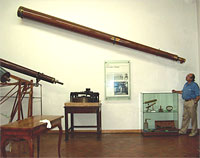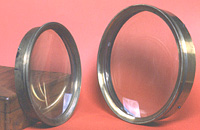Instruments
Refracting Telescope
At the Third Meeting of Italian scientists, held in Florence and for which the Tribuna di Galileo was inaugurated, on 28 September 1841 Amici read a paper about his achromatic telescope of 16 feet of focal distance (called by Tempel the Amici I), which he had had constructed in the workshops of the Museum of Physics and Natural History.
Prof. G. B. Amici read a paper about an achromatic telescope with a 16 foot focal distance constructed in the workshops of the Museum of Physics in Florence. He exhibited the object-glass (with an aperture of 11 inches), composed of crown and flint glass of the Guinand plant in Paris and carried out by the artist Toussain, who used the methods thought up by Prof. Amici himself to curve the glass and clean it. Prof. Amici explained that as for the work, this objective, like the other lenses of the telescope, could be said to be truly exact, since the aberrations of sphericity and refrangibility were well corrected. As for the quality of the glass, he pointed out a few imperfections it has along the circumference, that is seven groups of veins which can be seen in the crown, which refract the light irregularly and thus render the images less distinct.
 In the note On the physical appearances of the great comet of 1858, Donati spoke about this telescope with 28 cm of aperture and 5.2 m focal distance. At the time it was the largest refractor available in Italy. In reality, the objective lens of Amici had to wait for nearly three years before being supplied with its wooden tube.
In the note On the physical appearances of the great comet of 1858, Donati spoke about this telescope with 28 cm of aperture and 5.2 m focal distance. At the time it was the largest refractor available in Italy. In reality, the objective lens of Amici had to wait for nearly three years before being supplied with its wooden tube.
In the summer of 1844, during his second trip to Paris, Amici purchase two disks of flint glass from Guinand of 11 inches in diameter, with which he produced his second achromatic objective the following year (Amici II), of 9 inches (238 mm for a focal distance of 3.18m).
 Amici I, which Giovanni Battista Donati managed to place onto an equatorial mount only in 1865, was to be the main telescope of the Observatory annexed to the Museum. Ernst Wilhelm Tempel, who arrived in Arcetri in 1875, found this telescope mounted parallactically in the great dome with a mahogany tube and he used it to draw the nebulae. He described the two telescopes in a few handwritten notes, Osservazioni e disegni di alcune Nebule
Amici I, which Giovanni Battista Donati managed to place onto an equatorial mount only in 1865, was to be the main telescope of the Observatory annexed to the Museum. Ernst Wilhelm Tempel, who arrived in Arcetri in 1875, found this telescope mounted parallactically in the great dome with a mahogany tube and he used it to draw the nebulae. He described the two telescopes in a few handwritten notes, Osservazioni e disegni di alcune Nebule
< Observations and drawings of some Nebulae >, kept in the Library of the Astrophysical Observatory of Arcetri:
After having observed the skies for 16 years (one year in Venice and eleven years in Marseilles with only my own telescope with 4 inch aperture, and four years in Milan with a Plössl of the same size), and after having made about 20 discoveries among planets and comets, I arrived at the beginning of 1875 to the Arcetri Observatory. [...]
This Observatory has two large achromatic telescopes by Amici. The largest (which for brevity I call Amici I) has a 283 mm free aperture and 5.73 m focal distance, and a mahogany tube mounted parallactically in the great dome. Unfortunately, this mounting was done badly so that even standing on the highest step it is impossible to observe at a height on the horizon of less than 25 degrees. It is even lacking in the division of the circles in RA and Declination, so that he who said that he couldn’t understand how it would be possible to look for and draw nebulae with this telescope was not exaggerating.
The second telescope constructed by Amici (briefly, Amici II) has an aperture of 238 mm and only 3.18 meters of focal distance. This instrument, with its great power of light, could be very useful if it were mounted parallactically in the eastern dome. I have not been able to have this done until now, but I am hopeful that it will be possible. The current imperfect mounting is at best adequate to show the public the moon and the planets. It is impossible to measure on the open terrace, because its inclination makes the telescope vibrate with the lightest wind and we fear some unfortunate accident. When I first began working in Arcetri I sometimes used this telescope to look for nebulae but I could not make drawings with it.
I tried to do the same with the Amici I in the dome, and although it was very uncomfortable, some drawings were good. When I compared my sketches with the drawings published by other astronomers I realized that the Amici I made me see the nebulae as well as they had been first drawn using the largest telescopes in the world.
I continued in my work and I have made interesting experiments, e.g., that Amici I not only allowed me to see all of the nebulae of Herschel’s class III, all of the new nebulae of Lord Rosse and Lassel, but I also found many nebulae of W. Herschel which since their first discovery had not been observed nor found by anyone, and which many believed to have disappeared or to have been indicated badly.
Unfortunately, this excellent telescope has only one eyepiece (which belongs to Amici II at the same time) and only one of the series of eyepieces belonging to the small refractor telescope by Fraunhofer can be properly used on it. The magnification is therefore limited to from 113 to 190 times.
 The objective lenses of the two telescopes, pictured here and still kept at the Astrophysical Observatory of Arcetri, were still used in 1936 and 1952 during the two solar eclipses
The objective lenses of the two telescopes, pictured here and still kept at the Astrophysical Observatory of Arcetri, were still used in 1936 and 1952 during the two solar eclipses(cf. Guglielmo Righini, Storia e vicende degli obbiettivi astronomici di G. B. Amici, “Physis”, XI-1969; Alberto Righini, Il ruolo di Giovan Battista Amici e di Giovan Battista Donati nell'astronomia fiorentina del XIX secolo, “Giornale di Fisica”, 2/3-1988). The tubes are instead exhibited in a room of the Institute and Museum of the History of Science in Florence.
